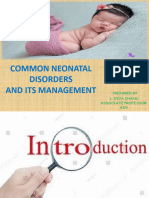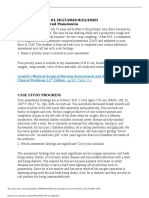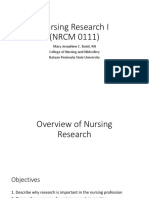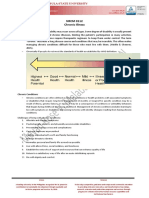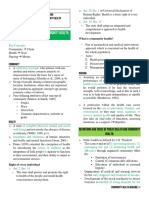Nasa Quiz
Nasa Quiz
Uploaded by
Yuuki Chitose (tai-kun)Original Description:
Original Title
Copyright
Available Formats
Share this document
Did you find this document useful?
Is this content inappropriate?
Report this DocumentCopyright:
Available Formats
Nasa Quiz
Nasa Quiz
Uploaded by
Yuuki Chitose (tai-kun)Copyright:
Available Formats
Newborn: Grade 1
LGA – infants’ wt is in the 90th% for neonates same Lag on respirations
gestational age, may be pre, post, or full term. Just visible
LGA – does not mean post term. Just visible
Minimal
LGA – most common cause: maternal diabetes. Stethoscope only
LGA – infant at risk: birth injuries, hypoglycaemia,
Grade 2
and polycythemia – macrosomia.
See-saw
Markes
SGA – infants whose wt is at or below 10th% Marked
SGA – results from failure to thrive Marked
Naked ear
SGA – is a high risk condition
SGA – does not mean premature
Meconium Aspiration Syndrome
SGA – causes: anything restricting utero-placental
blood flow, smoking, DM, PIH (Pregnancy Induced - Occurs most often among post term
Hypertension), Infections.
infants, decreased amniotic fluid/cord
SGA – complications: hypoglycemia, meconium compression.
aspiration, hypothermia, polycthemia
Neonatal Sepsis (Sepsis Neonatorum)
- A type of neonatal infection and specifically
Respiratory Distress Syndrome (RSD) refers to the presence in a newborn baby of a
RSD – also known as Hyaline Membrane Disease bacterial blood stream infection (BSI) (such as
meningitis, pneumonia, pyelonephritis, or
RSD – cause: prematurity, C/S, diabetic mother, gastroenteritis) in the setting fever.
birth asphyxia – interfere with surfactant
RSD – s&s: T R N C G S A Early-Onset sepsis (EOS) – first 72 hours of
life
Silverman-Andersen Index measures:
- Neonatal sepsis is the single most common
Upper chest
cause of neonatal death in hospital as well as
Lower chest
community in developing country.
Xiphoid retractions
Nares dilation - (Heart rate above 160) … tachycardia can
Expiratory grunt present up to 24 hours before the onset of
other signs.
Grade 0 - One risk for Group B Streptococcal Infection
(GBS) is Preterm Premature Rupture of
Synchronized Membranes (PPROM). Screening women for
No retractions GBS (via vaginal and rectal swabbing) and
None treating culture positive women with
None intrapartum chemoprophylaxis is reducing the
None number of neonatal sepsis caused by GBS.
NS Treatment: Infant:
Frequently treated with antibiotics empirically until Intussusception – is a medical condition in which
cultures are sufficiently proven to be negative. a part of the intestine folds into section next to it.
In addition to fluid resuscitation and supportive Risk factors:
care, a common antibiotic regimen in infants with
suspected sepsis is a beta-lactam antibiotic - Certain infection
(usually ampicillin) in combination with an - Disease like cystic fibrosis
aminoglycoside (usually gentamicin). - Intestinal polyps
Hyperbilirubinemia Failure to Thrive (FTT) – defined in term of weight,
and can be evaluated either by a low weight for
Phototherapy – bilirubin on skin changes into the child’s age, or by a low rate of increase in
water-soluble excreted in bile & urine. the weight.
“Bili” light placed inside warmer, need patches
over eyes, infant wearing only diaper or fiber-
optic phototherapy blanket against skin Endogenous (Organic)
Side effects: frequent, loos, green stools, skin Problems with the gastrointestinal system such
changes as excessive gas and acid reflux are painful
Can be used at home conditions which may make the child unwilling to
take in sufficient nutrition.
Other Interventions:
Exogenous (Non-organic) – sleepy baby syndrome
• Exchange transfusions – if lights not working
• Maintain neutral thermal environment – not too … conflicting setting and protracted emergencies,
hot or too cold exogenous faltering may be caused by chronic
food insecurity, lack of nutritional awareness,
• Provide optimal nutrition – hydrate and other factors beyond the caregiver control.
• Protecting the eyes from retinal damage
• Enhance therapy by exposing as much skin as
Mixed
possible to light, remove all clothing except diaper,
Child: act content
turn frequently
Caregiver: do not offer feedings of sufficient
frequency or volume
Child: with severe acid reflux, be in pain while
Others: eating
Caregiver: hesitant to offer sufficient feeding
A. Infant of a Diabetic Mother
Macrosomia: face round, red, body obese, Wasting – weight-for-height
poor muscle tone, irritable, tremors
Stunting – height-for-age
Most frequent symptom: jitteriness or
tremors
What is Sudden Infant Death Syndrome (SIDS)? Cause of DS:
− Major cause of death in infants after 1st month of − Trisomy 21 is caused by a failure of the 21st
life chromosome to separate during egg or sperm
− Sudden & silent in an apparently healthy infant development (nondisjunction).
− Unpredictable & unpreventable
− Quick death with no signs of suffering - usually − As a result, a sperm or egg cell is produced with
during sleep an extra copy of chromosome 21; this cell thus has
24 chromosomes.
Environment Assessment: − When combined with a normal cell from the other
parent, the baby has 47 chromosomes, with three
− Location of infant copies of chromosome 21.
− Presence of objects in area infant found
− Unusual conditions 88% mother
- High room temperature 8% father
- Odors 3% after the egg and sperm have merged
- Anything out of ordinary
Cleft Lip and Cleft Palate
Colic
Cause:
Baby Colic, also known as Infantile Colic, is defined
as episodes of crying for more than three hours a - Frontonasal Prominence (1) – from the top of the
day, for more than three days a week, for three head down towards the future upper lip;
weeks in an otherwise healthy child between the
ages of two weeks and four months. - Maxillar Prominence (2) – from the cheeks, which
meet the first lobe to form the upper lip; and
Colic is diagnosed after other potential causes of
crying are excluded. - Mandibular Prominence (2) – just below,
additional lobes grow from each side, which form
the chin and lower lip.
Treatment:
− Calming measures may be used and include: Clefts can also affect other parts of the face, such
- Swaddling with the legs flexed as the eyes, ears, nose, cheeks, and forehead.
- Holding the baby on its side or stomach
- Swinging the baby side to side or back and
forth while supporting the head
Treatment:
- Making a shushing sound, and breast
feeding. Rule of 10s – Wilhelmmesen and Musgrave in 1969
− Eye contact, talking, and holding the infant are
also reasonable measures, although it is not ✓ is at least 10 weeks of age;
entirely clear if these actions have any effect
beyond placebo. ✓ weighs at least 10 pounds, and
✓ has at least 10g haemoglobin
Trisomy 21/ Down Syndrome (DS) - typically
associated with physical growth delays, mild to
moderate intellectual disability, and characteristic
facial features.
Imperforated Anus - Meningocele – typically causes mild
problems with a sac of fluid present at the
Features: gap in the spine.
The classical Wingspread classification was in low - Myelomeningocele – also known as open
and high anomalies: spina bifida, is the most severe form.
− Low Lesion – colon remains close to the skin. In
this case, there may be a stenosis (narrowing) of Causes of Hydrocephalus:
the anus, or the anus may be missing altogether,
with the rectum ending in a blind pouch. Congenital
Acquired – as a consequence of CNS
− High Lesion – colon is higher up in the pelvis and
infections, Meningitis, Brain tumors, Head
there is a fistula connecting the rectum and the
trauma, or Intracranial Hemorrhage, and it is
bladder, urethra, or the vagina.
usually painful.
− Persistent Cloaca (from the term cloaca, an
Treatment:
analogous orifice in reptiles and amphibians), in
which the rectum, vagina and urinary tract are Endoscopic Third Ventriculostomy (ETV), an
joined into a single channel. alternative treatment for obstructive hydrocephalus
in selected people, a surgical opening in the floor of
the third ventricle allows the CSF to flow directly to
Associated Anomalies: the basal boilers, thereby shortcutting any
obstruction.
V – Vertebral Anomalies
A – Anal Atresia
C – Cardiovascular Anomalies
Cause of Otitis Media:
T – Tracheoesophageal Fistula
E – Esophageal Atresia − Because of the Eustachian tube dysfunction, the
R – Renal and/or Radial Anomalies gas volume in the middle ear is trapped and parts
L – Limb Defects of it are slowly absorbed by the surrounding
tissues, leading to negative pressure in the middle
ear.
While many surgical techniques to definitively
repair anorectal malformations have been − Eventually, the negative middle-ear pressure can
described, the posterior sagittal approach reach a point where fluid from the surrounding
(PSARP) has become the most popular. It involves tissues is sucked into the middle ear's cavity
dissection of the perineum without entry into the (tympanic cavity), causing a middle-ear effusion.
abdomen and 90% of defects in boys can be
repaired this way. − By reflux or aspiration of unwanted secretions
from the nasopharynx into the normally sterile
middle-ear space, the fluid may then become
infected – usually with bacteria.
Spina Bifida - A birth defect where there is
incomplete closing of backbone and membranes Types: AOM, OME, CSOM, Adhesive OM
around the spinal cord.
Chronic Supporative Otitis Media - Middle ear
Types: inflammation of greater than 2 weeks that results in
episodes of ear discharge for at least 6 weeks.
Spina Bifida Occulta
Spina Bifida Cystica
You might also like
- Topic: Recent Advances - Cardiac CT: Journal ClubDocument130 pagesTopic: Recent Advances - Cardiac CT: Journal Clubjai256No ratings yet
- Module No. Date: Topic:: Cues/Questions/ Keywords Notes Preterm InfantDocument10 pagesModule No. Date: Topic:: Cues/Questions/ Keywords Notes Preterm Infantanon ymousNo ratings yet
- Pediatric Nursing IiiDocument3 pagesPediatric Nursing IiiRizalyn Padua ReyNo ratings yet
- Care of The High Risk ChildDocument8 pagesCare of The High Risk ChildThe Journey of Becca StoneNo ratings yet
- 150327 Neonatal Sepsis 김세현 PDFDocument30 pages150327 Neonatal Sepsis 김세현 PDFirene aureliaNo ratings yet
- Down Syndrome, or Down's Syndrome Trisomy 21, or Trisomy G: Failure To ThriveDocument5 pagesDown Syndrome, or Down's Syndrome Trisomy 21, or Trisomy G: Failure To Thrivenobi012No ratings yet
- High RiskDocument52 pagesHigh RisksheenaabyNo ratings yet
- Module 11 Student Activity SheetDocument7 pagesModule 11 Student Activity SheetJenny Agustin Fabros100% (1)
- High Risk Newborn ReviwerDocument5 pagesHigh Risk Newborn ReviwerArianJubaneNo ratings yet
- Review UNIT XI High Risk NewbornDocument20 pagesReview UNIT XI High Risk NewbornShehana ShihabNo ratings yet
- High Risk NewbornDocument8 pagesHigh Risk NewbornKath ArabisNo ratings yet
- Jose, Leana Louisse D. Cornell Notes On Ncm109 Module 1 & 2 (Complications of Pregnancy) 02/18/21 Assessment For Risk FactorsDocument19 pagesJose, Leana Louisse D. Cornell Notes On Ncm109 Module 1 & 2 (Complications of Pregnancy) 02/18/21 Assessment For Risk FactorsLiana Louisse JoseNo ratings yet
- NCM109 Complete FinalsDocument15 pagesNCM109 Complete FinalsJhayneNo ratings yet
- Infections ViralesDocument8 pagesInfections ViralesGiovani AndemeNo ratings yet
- #2-NCM 109 - TransesDocument19 pages#2-NCM 109 - TransesJaimie BanaagNo ratings yet
- Final Polyhydramnios ReportDocument17 pagesFinal Polyhydramnios ReportJulianne Rei N. EladNo ratings yet
- Maternal LEC - Week 11 - TransesDocument4 pagesMaternal LEC - Week 11 - TransesEcka- EckaNo ratings yet
- Pediatric Nursing Common ProblemsDocument33 pagesPediatric Nursing Common ProblemsMaricel Agcaoili GallatoNo ratings yet
- Maternal FinalsDocument23 pagesMaternal FinalsJhayneNo ratings yet
- This Is Meant As A Guide and Not A Basis For Questions On The Subject Matter For The Examination - MVCDocument66 pagesThis Is Meant As A Guide and Not A Basis For Questions On The Subject Matter For The Examination - MVCStephen MontoyaNo ratings yet
- High Risk NewbornDocument4 pagesHigh Risk NewbornWenn Joyrenz ManeclangNo ratings yet
- Preterm Newborn: NCM 102 High Risk Newborn Problems Related To MaturityDocument11 pagesPreterm Newborn: NCM 102 High Risk Newborn Problems Related To MaturityXydl Jeziah Arl BangcongNo ratings yet
- Neonatal Sepsis-1Document35 pagesNeonatal Sepsis-1Mutai KiprotichNo ratings yet
- Nursing Care of The High Risk Newborn To MaturityDocument41 pagesNursing Care of The High Risk Newborn To MaturityMarie Ashley Casia100% (1)
- Ob PrelimsDocument13 pagesOb PrelimseliNo ratings yet
- #1-NCM 109 - TransesDocument10 pages#1-NCM 109 - TransesJaimie BanaagNo ratings yet
- Environmental TeratogensDocument19 pagesEnvironmental TeratogensChristine Pialan SalimbagatNo ratings yet
- High Risk NewbornDocument4 pagesHigh Risk NewbornKristie Kwin Alley FerreraNo ratings yet
- High Risk NewbornDocument25 pagesHigh Risk NewbornViji MNo ratings yet
- Obg PPT 1Document27 pagesObg PPT 1yash myatraNo ratings yet
- Kuliah Mahasiswan UPH, Neonatal SepsisDocument39 pagesKuliah Mahasiswan UPH, Neonatal Sepsiswilliam atmadjiNo ratings yet
- Percentile On An Intrauterine Growth Chart For ThatDocument2 pagesPercentile On An Intrauterine Growth Chart For ThatJanella Paz ReyesNo ratings yet
- LowbirthbabyDocument26 pagesLowbirthbabypreeti bagulNo ratings yet
- INFECTIONSDocument4 pagesINFECTIONSRico Shaun CalapreNo ratings yet
- High Risk NewbornDocument4 pagesHigh Risk NewbornHanna AligatoNo ratings yet
- MCPDocument3 pagesMCPChelsea CuevasNo ratings yet
- Common Neonatal DisordersDocument27 pagesCommon Neonatal DisordersLaishram Deeva ChanuNo ratings yet
- Prepregnancy and Preconception NutritionDocument4 pagesPrepregnancy and Preconception NutritionNobiliary ortizNo ratings yet
- Φ PathophysiologyDocument4 pagesΦ PathophysiologyMariah AshooriyanNo ratings yet
- Infectious Diseases in PregnancyDocument8 pagesInfectious Diseases in PregnancyPabinaNo ratings yet
- Fetal Growth DisordersDocument3 pagesFetal Growth DisordersBess RompalNo ratings yet
- Term PaperDocument85 pagesTerm PaperAbhilash PaulNo ratings yet
- High Risk Trans 1Document5 pagesHigh Risk Trans 1syroise margauxNo ratings yet
- Lecture On High Risk NewbornDocument51 pagesLecture On High Risk NewbornBilly RayNo ratings yet
- Neonatal Sepsis and Necrotizing EnterocolitisDocument47 pagesNeonatal Sepsis and Necrotizing EnterocolitisAljeirou AlcachupasNo ratings yet
- Maternal Midterm Newborn Infant DiseasesDocument37 pagesMaternal Midterm Newborn Infant DiseasesEya BaldostamonNo ratings yet
- Maternal Midterm Reviewer Common ProblemsDocument58 pagesMaternal Midterm Reviewer Common ProblemsEya BaldostamonNo ratings yet
- Prematurity DR KazevuDocument22 pagesPrematurity DR KazevuMoses Jr KazevuNo ratings yet
- My Paediatric NotesDocument14 pagesMy Paediatric NotesTicky TomNo ratings yet
- High Risk Ob Notes 1Document20 pagesHigh Risk Ob Notes 1pinpindalgoNo ratings yet
- PreTerm PPT PartialDocument96 pagesPreTerm PPT PartialJanseen EdizaNo ratings yet
- Ncma 219 Midterm ReviewerDocument4 pagesNcma 219 Midterm ReviewerCatie SantiagoNo ratings yet
- Nursing Notes 2nd YrDocument9 pagesNursing Notes 2nd YrMai CarbonNo ratings yet
- Neonatal SepsisDocument7 pagesNeonatal Sepsispaningbatan.kristine.bNo ratings yet
- Abortion, Ectopic PregnancyDocument139 pagesAbortion, Ectopic PregnancyINFORMASI MENARIKNo ratings yet
- Lesson 3.docx SemiDocument7 pagesLesson 3.docx SemiKc-Ann GalaponNo ratings yet
- M3.5 - NCM109 (High Risks Infants)Document89 pagesM3.5 - NCM109 (High Risks Infants)Kristil ChavezNo ratings yet
- Maternal MidtermsDocument14 pagesMaternal MidtermsKrisha CafongtanNo ratings yet
- Neontalinf 150325093401 Conversion Gate01Document86 pagesNeontalinf 150325093401 Conversion Gate01Sanjay Kumar SanjuNo ratings yet
- MCN Lect Multiple Pregnancy Hydramnios PosttermDocument5 pagesMCN Lect Multiple Pregnancy Hydramnios PosttermAmethystNo ratings yet
- 5.4 Darwins Theory of EvolutionDocument6 pages5.4 Darwins Theory of EvolutionYuuki Chitose (tai-kun)No ratings yet
- Comprehensive Drug Study Ketoanalogue PDF FreeDocument2 pagesComprehensive Drug Study Ketoanalogue PDF FreeYuuki Chitose (tai-kun)No ratings yet
- Choledecholithiasis Case StudyDocument8 pagesCholedecholithiasis Case StudyYuuki Chitose (tai-kun)No ratings yet
- ROLES RESPONSIBILITIES OF A MC NURSE IN CHALENGEING SITUATIONS Merged Compressed Merged MergedDocument53 pagesROLES RESPONSIBILITIES OF A MC NURSE IN CHALENGEING SITUATIONS Merged Compressed Merged MergedYuuki Chitose (tai-kun)No ratings yet
- CAP Case StudyDocument6 pagesCAP Case StudyYuuki Chitose (tai-kun)No ratings yet
- Physicians Perception About Electronic Medical Record System in Makkah Region, Saudi ArabiaDocument6 pagesPhysicians Perception About Electronic Medical Record System in Makkah Region, Saudi ArabiaYuuki Chitose (tai-kun)No ratings yet
- Budesonide Drug Study WWW RNpedia ComDocument3 pagesBudesonide Drug Study WWW RNpedia ComYuuki Chitose (tai-kun)No ratings yet
- What Is Community Health?: Art. 25 Sec. 1Document17 pagesWhat Is Community Health?: Art. 25 Sec. 1Yuuki Chitose (tai-kun)No ratings yet
- NI - Handout No.4Document29 pagesNI - Handout No.4Yuuki Chitose (tai-kun)No ratings yet
- NI - Handout No.2Document44 pagesNI - Handout No.2Yuuki Chitose (tai-kun)No ratings yet
- Pimpinio Erika Elaine M. Activity 3 Art Appreciation BSN 2cDocument3 pagesPimpinio Erika Elaine M. Activity 3 Art Appreciation BSN 2cYuuki Chitose (tai-kun)No ratings yet
- Case Study Week 1 Community Acquired Pneumonia 1Document6 pagesCase Study Week 1 Community Acquired Pneumonia 1Yuuki Chitose (tai-kun)No ratings yet
- Ivf ComputationDocument13 pagesIvf ComputationYuuki Chitose (tai-kun)0% (1)
- Matic Pablo Pantig Patungan Peralta Nursing Informatics Final Requirement Conduct of Research Writing Thru Scoping ReviewDocument11 pagesMatic Pablo Pantig Patungan Peralta Nursing Informatics Final Requirement Conduct of Research Writing Thru Scoping ReviewYuuki Chitose (tai-kun)No ratings yet
- TodllerDocument2 pagesTodllerYuuki Chitose (tai-kun)No ratings yet
- AbbreviationsDocument9 pagesAbbreviationsYuuki Chitose (tai-kun)No ratings yet
- Degenerate FibroidDocument3 pagesDegenerate FibroidYuuki Chitose (tai-kun)No ratings yet
- 1 - Overview of ResearchDocument22 pages1 - Overview of ResearchYuuki Chitose (tai-kun)No ratings yet
- NRCM0112 - Handout - Chronic IllnessDocument2 pagesNRCM0112 - Handout - Chronic IllnessYuuki Chitose (tai-kun)No ratings yet
- 2 - Quantitative and QualitativeDocument50 pages2 - Quantitative and QualitativeYuuki Chitose (tai-kun)No ratings yet
- Q&A Random Selection #16Document5 pagesQ&A Random Selection #16Yuuki Chitose (tai-kun)No ratings yet
- The Hell of Chronic Illness TranscriptDocument2 pagesThe Hell of Chronic Illness TranscriptYuuki Chitose (tai-kun)No ratings yet
- Q - A Random 8Document5 pagesQ - A Random 8Yuuki Chitose (tai-kun)No ratings yet
- What Is Community Health?: Art. 25 Sec. 1Document15 pagesWhat Is Community Health?: Art. 25 Sec. 1Yuuki Chitose (tai-kun)No ratings yet
- Q&A Random Selection #15Document5 pagesQ&A Random Selection #15Yuuki Chitose (tai-kun)No ratings yet
- Q - A Random 13Document6 pagesQ - A Random 13Yuuki Chitose (tai-kun)No ratings yet
- Q - A Random 14Document6 pagesQ - A Random 14Yuuki Chitose (tai-kun)No ratings yet
- Nutrition Across The LifespanDocument6 pagesNutrition Across The LifespanYuuki Chitose (tai-kun)No ratings yet
- Bumetanide Drug Study WWW RNpedia ComDocument2 pagesBumetanide Drug Study WWW RNpedia ComYuuki Chitose (tai-kun)No ratings yet
- Pathophysiology Model MCQDocument3 pagesPathophysiology Model MCQPrince Xavier100% (1)
- UntitledDocument4 pagesUntitledMadisyn OgburnNo ratings yet
- PVD Case ProformaDocument2 pagesPVD Case ProformaRiyaSinghNo ratings yet
- HLB, NME, M& M OSCE Notes - University of Manchester, WL GanDocument45 pagesHLB, NME, M& M OSCE Notes - University of Manchester, WL GanWeh Loong Gan100% (2)
- MCQ Asthma CopdDocument26 pagesMCQ Asthma Copdanisa930804No ratings yet
- Thyroid Disorders (Final Draft)Document17 pagesThyroid Disorders (Final Draft)mogesie1995No ratings yet
- Hematology Trans 10Document6 pagesHematology Trans 10Claire GonoNo ratings yet
- Heart Block TypesDocument4 pagesHeart Block TypesKurl JamoraNo ratings yet
- List of Anatomy Mnemonics - WikipediaDocument29 pagesList of Anatomy Mnemonics - WikipediaLeonNo ratings yet
- Practice Test 2 Upper LimbDocument4 pagesPractice Test 2 Upper LimbhavokkNo ratings yet
- KOGA AnalysisDocument6 pagesKOGA AnalysisLenka KořínkováNo ratings yet
- Chatterjee & Topol - Cardiac DrugsDocument529 pagesChatterjee & Topol - Cardiac DrugsDitoiu Adriana100% (1)
- ECGDocument33 pagesECGTamia PutriNo ratings yet
- Cardiorenal SyndromeDocument8 pagesCardiorenal SyndromeJeremia KurniawanNo ratings yet
- Pharmacology of Drugs Acting On Sympathetic Nervous SystemDocument65 pagesPharmacology of Drugs Acting On Sympathetic Nervous SystemCharles DapitoNo ratings yet
- Dr. Naitik D Trivedi & Dr. Upama N. Trivedi: 10. Urinary SystemDocument27 pagesDr. Naitik D Trivedi & Dr. Upama N. Trivedi: 10. Urinary SystemKunal DangatNo ratings yet
- The Cardiac GlycosidesDocument19 pagesThe Cardiac Glycosidesrx_loooly100% (4)
- Associations Between Dental Caries and Systemic Diseases: A Scoping ReviewDocument35 pagesAssociations Between Dental Caries and Systemic Diseases: A Scoping ReviewLeila FrotaNo ratings yet
- Summary CVS Davidson 23rdDocument5 pagesSummary CVS Davidson 23rdDeshi SportsNo ratings yet
- Second Semister Corce Comtemt 2 KMUDocument10 pagesSecond Semister Corce Comtemt 2 KMUHasin's QueenNo ratings yet
- 3 Post Test PediaDocument4 pages3 Post Test PediaJanine BaticbaticNo ratings yet
- Gastrointestinal Disorders PnleDocument23 pagesGastrointestinal Disorders Pnledelieup02100% (2)
- Hemodynamic Disorders: By: Dr. SL RasonableDocument59 pagesHemodynamic Disorders: By: Dr. SL RasonableJenneth Marquez JoloNo ratings yet
- Cerebral AneurysmDocument6 pagesCerebral Aneurysmamysong772No ratings yet
- Cambridge International AS & A Level: BIOLOGY 9700/22Document20 pagesCambridge International AS & A Level: BIOLOGY 9700/22Syed HalawiNo ratings yet
- Chapter 17 - BREATHING AND EXCHANGE OF GASESDocument7 pagesChapter 17 - BREATHING AND EXCHANGE OF GASESprernatiwary508No ratings yet
- Drug StudyDocument4 pagesDrug StudyForbidden fruitNo ratings yet
- Pathophysiology of Diabetic Ketoacidosis and Hyperglycemic Hyperosmolar Nonketotic Syndrome EtiologyDocument2 pagesPathophysiology of Diabetic Ketoacidosis and Hyperglycemic Hyperosmolar Nonketotic Syndrome EtiologyJaylord VerazonNo ratings yet
- Respiratory Emergency First AidDocument13 pagesRespiratory Emergency First AidFaithNo ratings yet




































